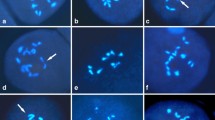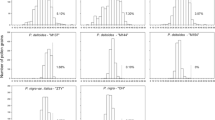Summary
-
1.
The morphological characters of six species and six F1 hybrids were compared in detail in the present study. It was observed that with respect to metrical characters the hybrids were intermediate in some cases but in certain others hybrid vigour was also met with.
-
2.
Pachytene pairing was complete and apparently normal, followed by regular meiosis at later stages resulting in high pollen fertility and good seed setting in all the parental species except the male sterile “Kafir”. Studies on the pairing properties of the differentially stained regions showed that synapsis starts from the proximal to the distal end and separation of the split chromosomes starts from the distal to the proximal.
-
3.
Pachytene analysis in the hybrids,S. nervosum×S. sudanense and M. S. “Kafir”×S. arundinaceum revealed the presence of some minute, though cytologically detectable, structural differences such as terminal and interstitial nonpairing segments, terminal deletion etc. High percentage of fertile pollen and good seed setting were recorded in these hybrids. It is suggested that the existing chromosomal differences are quite small and do not lead to abnormal behaviour of the hybrids either in respect of morphological characters or in the meiotic process in the F1 generation. Pachytene analysis in the remaining four F1 hybrids was complete, followed by regular meiosis at later stages resulting in high percentage of stainable pollen and good seed set.
-
4.
Cytogenetical mechanisms underlying species differentiation in the genus are discussed.
Zusammenfassung
-
1.
In der vorliegenden Arbeit wurden die morphologischen Eigenschaften von 6 Arten und 6 F1-Bastarden verglichen. Dabei konnte beobachtet werden, daß sich die Bastarde in ihren meßbaren Eigenschaften in einigen Fällen intermediär verhielten, in bestimmten anderen traten jedoch Heterosiseffekte auf.
-
2.
Der vollständigen und offensichtlich normalen Pachytänpaarung folgte eine reguläre Meiose, hohe Pollenfertilität und in allen Elternarten mit Ausnahme der männlich sterilen “Kafir” ein guter Samenansatz. Untersuchungen über das Paarungsvermögen differentiell gefärbter Abschnitte zeigten, daß die Synapsis von proximal nach dem distalen Ende zu fortschreitet und die Trennung der gespaltenen Chromosomen distal beginnt und sich nach proximal fortsetzt.
-
3.
Die Pachytän-Analyse in den BastardenS. nervosum×S. sudanense und M. S. “Kafir”×S. arundinaceum ergab das Vorhandensein einiger kleiner, jedoch cytologisch erkennbarer Strukturunterschiede, wie terminale und interstitielle nichtpaarende Abschnitte, terminale Deletionen usw. Ein hoher Prozentsatz von fertilen Pollen und guter Samenansatz wurde in diesen Bastarden festgestellt. Es wird angenommen, daß die bestehenden chromosomalen Unterschiede nur klein sind und nicht zu abnormalem Verhalten der Bastarde im Hinblick auf morphologische Eigenschaften oder den Meioseablauf in der F1-Generation führen. Die Pachytän-Analyse in den übrigen 4 F1-Bastarden ergab vollständige Paarung gefolgt von einer auch in den späteren Stadien regulären Meiose, hohem Prozentsatz färbbarer Pollen und gutem Samenansatz.
-
4.
Die cytogenetischen Mechanismen, die der Artendifferenzierung in der Gattung zugrundeliegen, werden diskutiert.
Similar content being viewed by others
Literature
Anderson, E.: Inclusive herbaria. Indian J. Genet.11:1–4 (1955).
Celarier, R. P.: Cytotaxonomy of the Andropogoneae III. Sub-tribe Sorgheae, genusSorghum. Cytologia (Tokyo)23, 395–418 (1958).
Daura, B. N., andG. L. Stebbins: A polyhaploid obtained from a hybrid derivative ofSorghum halepense×S. vulgare var.sudanense. Genetics37, 369–374 (1952).
Endrizzi, J. E.: Cytological studies of some species and hybrids in theEu-Sorghums. Bot. Gaz.119, 1–10 (1957).
Garber, E. D.: Cytotaxonomic studies in the genusSorghum. Univ. Calif. Pub. Bot.23, 283–362 (1950).
Hadley, H. H.: Cytological relationship betweenSorghum vulgare andS. halepense. Agron. J.45, 139–143 (1953).
Harland, S. C.: The genetics of Cotton. Jonathan Cape. London, 1939.
Kidd, H. J.: Studies onSorghums. Ph. D. Thesis. Washington Univ. (1956).
Krishnaswamy, N., V. S. Raman andP. Chandra-sekharan: An interspecific hybrid of grain sorghum (S. roxburghii, 2n=20) and Johnson grass (S. halepense, 2n=20). Curr. Sci.25, 195–197 (1956).
Laubscher, F. X.: Union of South Africa Department of Agriculture and Forestry. Sci. Bull. 242 (1945).
Magoon, M. L., D. C. Cooper andR. W. Hougas: Cyto genetic studies of some diploidSolanums, Section Tuberarium. Amer. J. Bot.45, 207–221 (1958).
Magoon, M. L., andK. G. Shambulingappa Karyomorphology Chromosome inSorghum ankolib var.annalibred, aEu-Sorghum. Indian J. Genet.20, 166–177 (1960).
Magoon, M. L., andK. G. Shambulingappa: Karyomorphology inSorghum propinquum and its bearing on the origin of 40-chromosome-Sorghums. Chromosoma (Berl.)12, 460 bis 465 (1961).
Magoon, M. L., andK. G. Shambulingappa: Cytological and morphological studies on some interspecific hybrids inEu-Sorghum. Z. Vererb.93, 13–24 (1961).
Macoon, M. L., K. G. Shambulingappa, andM. S. Ramanna: Chromosome morphology and meiosis in someEu-Sorghums. Cytologia (Tokyo)26, 236–252 (1961).
Magoon, M. L., andM. S. Ramanna: Comparative karyomorphology ofEu-Sorghum. Caryologia14, 391–407 (1961).
Magoon, M. L., andM. S. Ramanna: Cytology of someEu-Sorghums (in press) (1961).
Sharma, A. K., and (Miss)Dipti Bhattacharjee: Chromosome studies inSorghum-I. Cytologia (Tokyo)22, 287 to 311 (1957).
Snowden, J. D.: A classification of the cultivatedSorghums. Kew Bull.21, 221–254 (1935).
Snowden, J. P.: The cultivated races ofSorghum. Adlard & Son, Ltd. London, 1936.
Stebbins, G. L., J. I. Valencia andR. M. Malencia: Artificial and natural hybrids in gramineae, tribe Hordeae I.Elymus, Sitanion andAgropyron. Amer. J. Bot.33, 338–351 (1946).
Swaminathan, M. S., M. L. Magoon andK. L. Mehra: A simple propionocarmine PMC smear method for plants with small chromosomes. Indian J. Genet.14, 87–88 (1954).
Author information
Authors and Affiliations
Additional information
With 10 Figures
Rights and permissions
About this article
Cite this article
Magoon, M.L., Shambulingappa, K.G. Cyto-morphological studies on some species and species hybrids in the genusSorgbum . Der Züchter 32, 317–323 (1962). https://doi.org/10.1007/BF00709839
Issue Date:
DOI: https://doi.org/10.1007/BF00709839




